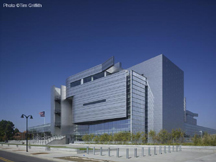|
|
Sustainable Design -->
Wayne L. Morse Courthouse (Eugene, OR)
LEED Gold
Project Team
| GSA Contact: |
Richard Broderick, Project Manager |
| Owner: |
U.S. General Services Administration |
| Architect: |
DLR Group, Portland, OR |
| Contractor: |
J. E. Dunn Construction, Portland, OR |
| Sq. Ft.: |
308,919 |
| Completed: |
Substantial completion: Oct. 2006. Building dedication: Dec. 1, 2006 |

-
BMP (Best Management Practices) are followed on the site in the event of any construction.
-
Erosion and sedimentation control plan equal to or more stringent than the referenced EPA standard.
-
Located within an area with a density of at least 60,000 square feet of building floor space per acre (2-story downtown development).
-
The building is within a 1/4 mile of two established bus routes and is within ½ mile of a public rail station.
-
50% of the on-site parking stalls are located underground.
-
Bicycle storage and shower/ changing rooms available for alternative transportation for occupants
-
71,537 s.f. of the site area (approx. 60% of the non-building area) has been planted with native or adaptive species
-
The project has provided open space adjacent to the building that is equal to the building footprint.
-
The project has reduced the storm water runoff rate by 31% and runoff quantity by 26% from pre-development conditions.
Water Efficiency
-
Water-efficient landscaping - the installed irrigation systems reduce potable water consumption by 59% from a calculated baseline case.
-
Water use reduction - that the project has reduced potable water use by 43.2% from a calculated baseline design through the installation of waterless urinals, low flow restroom lavatories, low-flow urinals, and low-flow kitchen sinks.
Energy & Atmosphere
-
The building has documentation for a comprehensive building operation plan for how all building systems should operate including the heating system, cooling system, humidity control system, lighting system, and the building automation controls. This included a comprehensive retro-commissioning plan and documentation of how repairs and upgraded were performed.
-
Optimized energy performance - the project performs 38.39% better than ASHRAE 90.1-1999 requirements using the LEED ECB method. Energy efficiency measures incorporated into the building design include high efficiency lighting with daylighting controls, underfloor air distribution with radiant heating, high efficiency chillers with one heat recovery chiller, and high efficiency condensing boilers.
-
Additional commissioning requirements have been completed or are under contract to be completed.
-
The project's resulting combined LCGWP and LCODP is 52.3.
-
The project has purchased Renewable Energy Certificates (RECs), equal to 50% of the project's energy consumption, that meets the Green-E definition for renewable energy for a minimum two years.
Materials & Resources
-
Diverted 90% of on-site generated construction waste from landfill
-
20% of the total building materials content, by value, have been manufactured using recycled materials
-
31% of the total building materials (by cost) have been manufactured within 500 miles of the project site
-
16% of the total building materials value (52.18% of the locally manufactured materials) have been manufactured using raw materials that were harvested, extracted, or recovered within 500 miles of the project site
Indoor Environmental Quality (IEQ)
-
CO2 sensors monitor to outside ambient levels and increased ventilation if exceeding thresholds
-
HVAC design complies with the recommended design approaches in ASHRAE 2001 Fundamentals Chapter 32, Space Air Diffusion
-
Two-week flush-out period conducted prior to occupancy; construction IAQ Management plan was in compliance with SMACNA guidelines, during construction, MERV 8 filters were installed at grilles
-
Low Emitting adhesives, sealants, paints, and carpets were used.
-
Thermal comfort monitoring system installed for relative humidity and temperature
-
Documentation showing the ventilation system is in compliance with ASHRAE 62-99 for each space type specified
Innovation and Design
-
Green Housekeeping Program
-
The project has reduced potable water use by 43.2% from a calculated baseline design through the installation of waterless urinals, low flow restroom lavatories, low-flow urinals, and low-flow kitchen sinks.
-
20% of the total building materials content, by value, have been manufactured using recycled materials.
-
An education program has been developed to present the project's sustainable design practices to occupants and visitors to the facility. The program includes a published brochure describing the project's design features and the LEED program, public tours, and press communications regarding the green features of the project.
-
LEED Accredited Professional (Scott Lewis)
Last Reviewed 4/6/2009
|